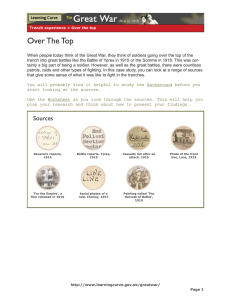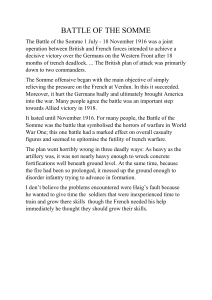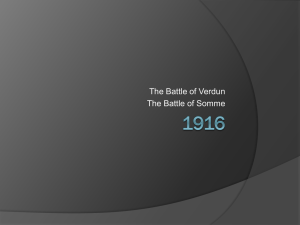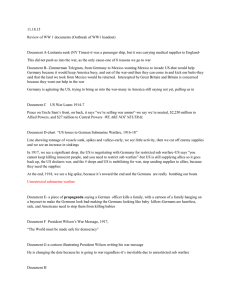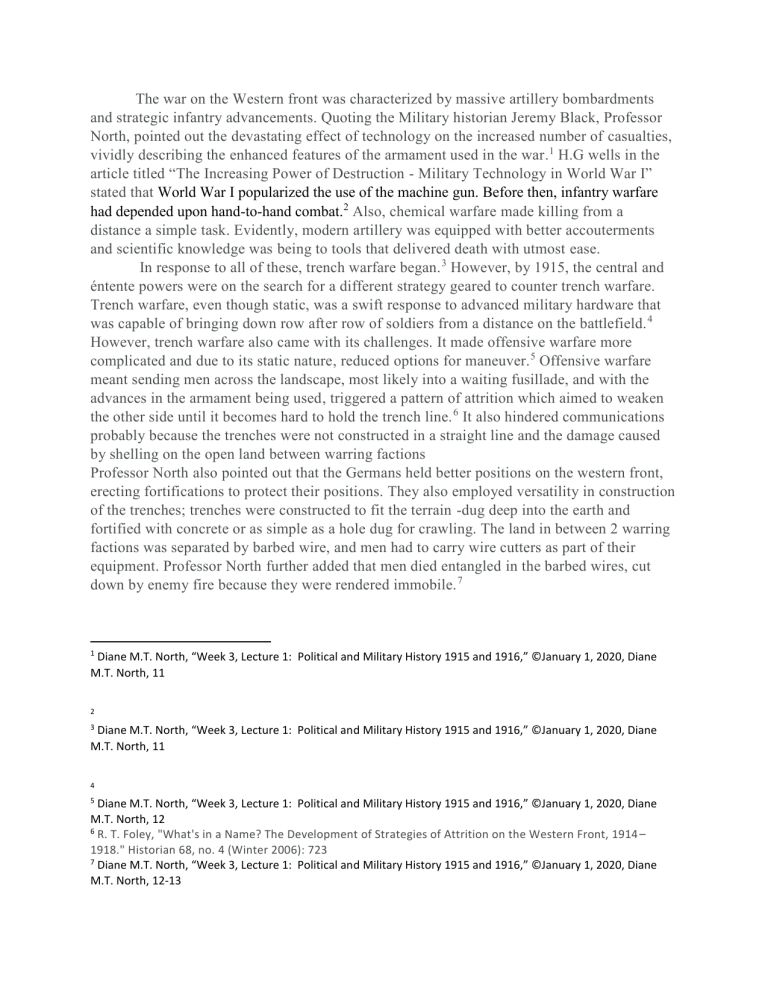
The war on the Western front was characterized by massive artillery bombardments and strategic infantry advancements. Quoting the Military historian Jeremy Black, Professor North, pointed out the devastating effect of technology on the increased number of casualties, vividly describing the enhanced features of the armament used in the war.1 H.G wells in the article titled “The Increasing Power of Destruction - Military Technology in World War I” stated that World War I popularized the use of the machine gun. Before then, infantry warfare had depended upon hand-to-hand combat.2 Also, chemical warfare made killing from a distance a simple task. Evidently, modern artillery was equipped with better accouterments and scientific knowledge was being to tools that delivered death with utmost ease. In response to all of these, trench warfare began. 3 However, by 1915, the central and éntente powers were on the search for a different strategy geared to counter trench warfare. Trench warfare, even though static, was a swift response to advanced military hardware that was capable of bringing down row after row of soldiers from a distance on the battlefield. 4 However, trench warfare also came with its challenges. It made offensive warfare more complicated and due to its static nature, reduced options for maneuver. 5 Offensive warfare meant sending men across the landscape, most likely into a waiting fusillade, and with the advances in the armament being used, triggered a pattern of attrition which aimed to weaken the other side until it becomes hard to hold the trench line. 6 It also hindered communications probably because the trenches were not constructed in a straight line and the damage caused by shelling on the open land between warring factions Professor North also pointed out that the Germans held better positions on the western front, erecting fortifications to protect their positions. They also employed versatility in construction of the trenches; trenches were constructed to fit the terrain -dug deep into the earth and fortified with concrete or as simple as a hole dug for crawling. The land in between 2 warring factions was separated by barbed wire, and men had to carry wire cutters as part of their equipment. Professor North further added that men died entangled in the barbed wires, cut down by enemy fire because they were rendered immobile. 7 1 Diane M.T. North, “Week 3, Lecture 1: Political and Military History 1915 and 1916,” ©January 1, 2020, Diane M.T. North, 11 2 3 Diane M.T. North, “Week 3, Lecture 1: Political and Military History 1915 and 1916,” ©January 1, 2020, Diane M.T. North, 11 4 5 Diane M.T. North, “Week 3, Lecture 1: Political and Military History 1915 and 1916,” ©January 1, 2020, Diane M.T. North, 12 6 R. T. Foley, "What's in a Name? The Development of Strategies of Attrition on the Western Front, 1914 – 1918." Historian 68, no. 4 (Winter 2006): 723 7 Diane M.T. North, “Week 3, Lecture 1: Political and Military History 1915 and 1916,” ©January 1, 2020, Diane M.T. North, 12-13 As stated earlier, the Germans held better positions and between April 22, 1915, and May 31, 1915,the second battle of Ypres, according to Will Irwin, a battle which will probably be known in history as the hardest and hottest which has yet developed on the extreme Western front.8 The Germans unleashed chlorine gas against the French, it was an onslaught that worked. As related by Irwin, the British and French slaughtered the Germans heavily with machinegun and rifle fire, before the Germans threw in their surprise attack, which succeeded in breaking the line of the French troops. 9 He narrated the use of the gas against Canadian forces, which, thanks to the wind, did not have as much effect at first; however, continual use against the Canadian forces caused some losses. 10 Consequently, the battle of Verdun in France, reputed to be the most extended campaign of the war and lasted between February 21 to December 18, 1914.According to Professor North, the French borrowed a leaf from the encounter the Germans had with the Belgians in 1914 that resulted in the battering of Belgian forts. Hence the French troops moved most of their more massive artillery from the forts around Verdun to other battlefields. 11 Professor North further wrote that the Germans had an advantage because the main railro ad line of the German army was behind them, facilitating the delivery of weapons and troops. A notable strategy of the Germans was the adjustment made to the use of mobile infantrymen viz a viz trench warfare. Both sides suffered immense casualties. In a writ on Verdun by Lord Radcliffe, he pondered why the Germans were bent on breaking the French line.12 He wondered if the quest was political or economic. The United States had been neutral in the war, but they were considering giving loans to those who needed it, on the premise that if the opportunity is not seized, the business will go to other nations like Argentina or Canada. The idea was that even though the business will eventually come, but at a crucial moment it is so great an opportunity that should not be passed up.13 He further wrote that compared to the losses incurred by the Germans, French losses were insignificant, going by verified conversations with members of the British, French, and American Red Cross Societies, people who are obviously in a position to know the truth about 8 Will Irwin, “Articles for the New York Tribune, April 25, 26, 27, 1915,"World War I Document Archive, courtesy of Brigham Young University Library, http://wwi.lib.byu.edu/index.php/The_Use_of_Poison_Gas 9 Ibid., Ibid., 11 Diane M.T. North, “Week 3, Lecture 1: Political and Military History 1915 and 1916,” ©January 1, 2020, Diane M.T. North, 18 10 12 Alfred Harmsworth, First Lord Northcliffe, “Battle of Verdun, March 4, 1916,” World War I Document Archive, courtesy of Brigham Young University Library, http://wwi.lib.byu.edu/index.php/Lord_Northcliff_on_Verdu 13 “U.S. Policy on War Loans to Belligerent Nations, 1914-1915” World War I Document Archive, courtesy of Brigham Young University Library, http://wwi.lib.byu.edu/index.php/U.S._Policy_on_War_Loans_to_Belligerents the number of casualties. 14 He further implied that apart from the onslaught being carried out when nature was unfavorable, the benefits of the war to the Germans were small. He, however, suggested that the propaganda could probably be a result of economic pressure, which led the Germans to erroneously believe taking over the French line at Verdun could end the war. However, the body count, according to professor North- the Germans had 337,000 casualties while the French suffered 377,231 casualties. 15 In the Battle of Somme, France, the Germans again appeared to demonstrate their acumen in warfare by successfully protecting themselves from a week-long artillery campaign that devastated the terrain the British soldiers crossed and did not destroy Germany's artillery or men.16 In a battle which Professor North tagged ”synonymous with slaughter” the seemimgly "good fortune" of the Germans was attributed to possession of intelligence, which the Brits probably did not have. However, the British troops learned to fire over the landscape and aim better with the aid of mathematical calculations that helped to prevent the terrain from destruction compared to what was in vogue previously. 17Lloyd George writes in his memoirs that It ranks with Verdun as one of the two bloodiest battles ever fought on this earth up to that date. The casualties on both sides were well over a million. He admitted that even though the battle was rumored to have claimed the finest of the Germans, it took more promising French citizens. 18 The war between the Italians and Austria -Hungary started on May 23, 1915, and, according to Professor North, began the four of eleven battles along the Isonzo River in Northeastern Italy. The Italians held the line, despite the offensive attack launched against them by the Austrians. A point worth of mention d the fact that the Austrians fought from high ground, continually shelling the Italian from above while the Italians fought in a steep mountain slopes of the laps in terrible conditions. In the first four battles out of a total of eleven, the Italians suffered 235,000 loses .they held the line but not without significant loses.19Details from the map showed that the Austrians succeeded in beating the Italians back right from the first attack and subsequently, even though the Italians put up a good defense. 20 14 Ibid Diane M.T. North, “Week 3, Lecture 1: Political and Military History 1915 and 1916,” ©January 1, 2020, Diane M.T. North, 16 15 16 Ibid.,21-22 17 Ibid.,22 18 David Lloyd George, “Battle of the Somme, July 1, 1916,” World War I Document Archive, courtesy of Brigham Young University Library, http://wwi.lib.byu.edu/index.php/Lloyd_George_on_the_Battle_of_the_Somme. Retrieved from War Memoirs of David Lloyd George, 1915-1916 (Boston: Little, Brown, 1933): 9-10 19 Diane M.T. North, “Week 3, Lecture 1: Political and Military History 1915 and 1916,” ©January 1, 2020, Diane M.T. North, 23 20 Ibid.,24
